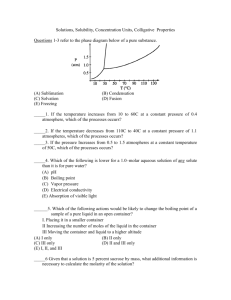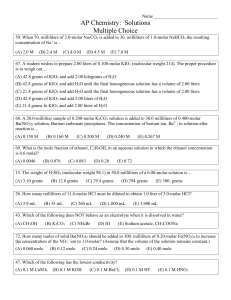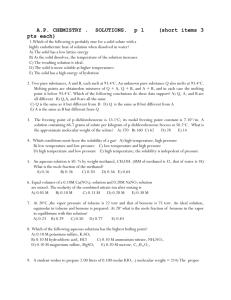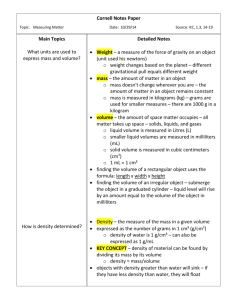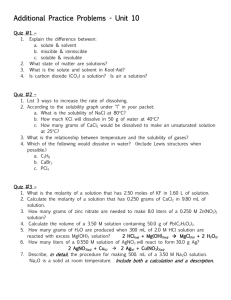File
advertisement
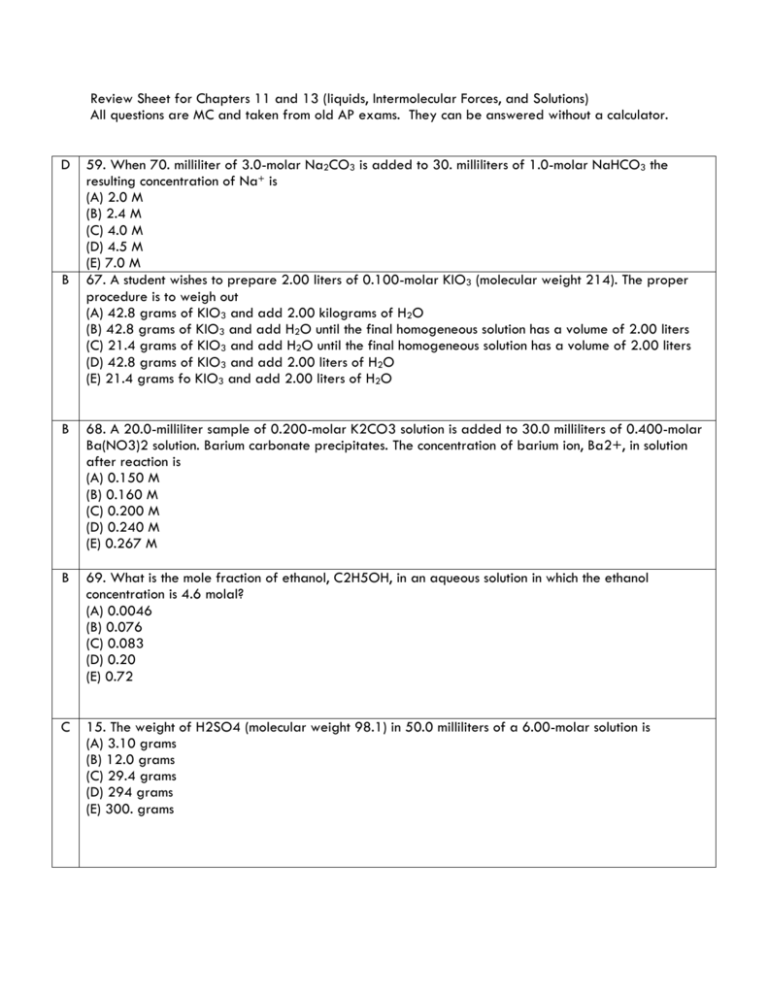
Review Sheet for Chapters 11 and 13 (liquids, Intermolecular Forces, and Solutions) All questions are MC and taken from old AP exams. They can be answered without a calculator. D B 59. When 70. milliliter of 3.0-molar Na2CO3 is added to 30. milliliters of 1.0-molar NaHCO3 the resulting concentration of Na+ is (A) 2.0 M (B) 2.4 M (C) 4.0 M (D) 4.5 M (E) 7.0 M 67. A student wishes to prepare 2.00 liters of 0.100-molar KIO3 (molecular weight 214). The proper procedure is to weigh out (A) 42.8 grams of KIO3 and add 2.00 kilograms of H2O (B) 42.8 grams of KIO3 and add H2O until the final homogeneous solution has a volume of 2.00 liters (C) 21.4 grams of KIO3 and add H2O until the final homogeneous solution has a volume of 2.00 liters (D) 42.8 grams of KIO3 and add 2.00 liters of H2O (E) 21.4 grams fo KIO3 and add 2.00 liters of H2O B 68. A 20.0-milliliter sample of 0.200-molar K2CO3 solution is added to 30.0 milliliters of 0.400-molar Ba(NO3)2 solution. Barium carbonate precipitates. The concentration of barium ion, Ba2+, in solution after reaction is (A) 0.150 M (B) 0.160 M (C) 0.200 M (D) 0.240 M (E) 0.267 M B 69. What is the mole fraction of ethanol, C2H5OH, in an aqueous solution in which the ethanol concentration is 4.6 molal? (A) 0.0046 (B) 0.076 (C) 0.083 (D) 0.20 (E) 0.72 C 15. The weight of H2SO4 (molecular weight 98.1) in 50.0 milliliters of a 6.00-molar solution is (A) 3.10 grams (B) 12.0 grams (C) 29.4 grams (D) 294 grams (E) 300. grams C 26. How many milliliters of 11.6-molar HCl must be diluted to obtain 1.0 liter of 3.0-molar HCl? (A) 3.9 mL (B) 35 mL (C) 260 mL (D) 1,000 mL (E) 3,900 mL A 43. Which of the following does NOT behave as an electrolyte when it is dissolved in water? (A) CH3OH (B) K2CO3 (C) NH4Br (D) HI (E) Sodium acetate, CH3COONa A 72. How many moles of solid Ba(NO3)2 should be added to 300. milliliters of 0.20-molar Fe(NO3)3 to increase the concentration of the NO3¯ ion to 1.0-molar? (Assume that the volume of the solution remains constant.) (A) 0.060 mole (B) 0.12 mole (C) 0.24 mole (D) 0.30 mole (E) 0.40 mole E 28. Given that a solution is 5 percent sucrose by mass, what additional information is necessary to calculate the molarity of the solution? I. The density of water II. The density of the solution III. The molar mass of sucrose (A) I only (B) II only (C) III only (D) I and III (E) II and III 47. Which of the following has the lowest conductivity? (A) 0.1 M CuS04 (B) 0.1 M KOH (C) 0.1 M BaCl2 (D) 0.1 M HF (E) 0.1 M HNO3 D E C 53. If 87 grams of K2 SO4 (molar mass 174 grams) is dissolved in enough water to make 250 milliliters of solution, what are the concentrations of the potassium and the sulfate ions? [K+] [SO42¯] (A) 0.020 M 0.020 M (B) 1.0 M 2.0 M (C) 2.0 M 1.0 M (D) 2.0 M 2.0 M (E) 4.0 M 2.0 M 33. A 1.0 sample of an aqueous solution contains 0.10 mol of NaCl and 0.10 mol of CaCl2. What is the minimum number of moles of AgNO3 that must be added to the solution in order to precipitate all of the Cl¯ as AgCl(s) ? (Assume that AgCl is insoluble.) (A) 0.10 mol (B) 0.20 mol (C) 0.30 mol (D) 0.40 mol (E) 0.60 mol A 56. A yellow precipitate forms when 0.5 M NaI(aq) is added to a 0.5 M solution of which of the following ions? A) Pb2+(aq) B) Zn2+(aq) C) CrO42¯(aq) D) SO42¯(aq) E) OH¯(aq) C 59. A 40.0 mL sample of 0.25 M KOH is added to 60.0 mL of 0.15 M Ba(OH)2. What is the molar concentration of OH¯(aq) in the resulting solution? (Assume that the volumes are additive) A) 0.10 M B) 0.19 M C) 0.28 M D) 0.40 M E) 0.55 M C 69. What is the final concentration of barium ions, [Ba2+], in solution when 100. mL of 0.10 M BaCl2(aq) is mixed with 100. mL of 0.050 M H2SO4(aq)? A) 0.00 M B) 0.012 M C) 0.025 M D) 0.075 M E) 0.10 M A 70. When 100 mL of 1.0 M Na3PO4 is mixed with 100 mL of 1.0 M AgNO3, a yellow precipitate forms and [Ag+] becomes negligibly small. Which of the following is a correct listing of the ions remaining in solution in order of increasing concentration? A) [PO43¯] < [NO3¯] < [Na+] B) [PO43¯] < [Na+]<[NO3¯] C) [NO3¯] < [PO43¯] < [Na+] D) [Na+] < [NO3¯] < [PO43¯] E) [Na+] < [PO43¯] < [NO3¯] E 71. In a qualitative ananlysis for the presence of Pb2+, Fe2+, and Cu2+ ions in a aqueous solution, which of the following will allow the separation of Pb2+ from the other ions at room temperature? A) Adding dilute Na2S(aq) solution B) Adding dilute HCl(aq) solution C) Adding dilute NaOH(aq) solution D) Adding dilute NH3(aq) solution E) Adding dilute HNO3(aq) solution D 73. The volume of distilled water that should be added to 10.0 mL of 6.00 M HCl(aq) in order to prepare a 0.500 M HCl(aq) solution is approximately A) 50.0 mL B) 60.0 mL C) 100. mL D) 110. mL E) 120. mL C 58. On a mountaintop, it is observed that water boils at 90°C, not at 100°C as at sea level. This phenomenon occurs because on the mountaintop the A) equilibrium water vapor pressure is higher due to the higher atmospheric pressure B) equilibrium water vapor pressure is lower due to the higher atmospheric pressure C) equilibrium water vapor pressure equals the atmospheric pressure at a lower temperature D) water molecules have a higher average kinetic energy due to the lower atmospheric pressure E) water contains a greater concentration of dissolved Gas E 27. The critical temperature of a substance is the (A) temperature at which the vapor pressure of the liquid is equal to the external pressure (B) temperature at which the vapor pressure of the liquid is equal to 760 mm Hg (C) temperature at which the solid, liquid, and vapor phases are all in equilibrium (D) Temperature at which liquid and vapor phases are in equilibrium at I atmosphere (E) lowest temperature above which a substance cnnot be liquified at any applied pressure A 54. Which of the following statements is always true about the phase diagram of any one-component system? (A) The slope of the curve representing equilibrium between the vapor and liquid phases is positive. (B) The slope of the curve representing equilibrium between the liquid and solid phases is negative. (C) The slope of the curve representing equilibrium between the liquid and solid phases is positive. (D) the temperature at the triple point is greater than the normal freezing point. (E) The pressure at the triple point is greater than 1 atmosphere. A 21. Which of the following is true at the triple point of a pure substance? (A) The vapor pressure of the solid phase always equal the vapor pressure of the liquid phase. (B) The temperature is always 0.01 K lower that the normal melting point. (C) The liquid and gas phases of the substance always have the same density and are therefore indistinguishable. (D) the solid phase always melts if the pressure increases at constant temperature. (E) The liquid phase always vaporizes if the pressure increases at constant temperature. C B D 49. Use the following diagram for 49-51. 49. The normal boiling point of the substanced represented by the phase diagram above is (A) -15 °C (B) -10 °C (C) 140 °C (D) greater than 140 °C (E) not determinable from the diagram 50. The phase diagram above provides sufficient information for determining the (A) Entrop. change on vaporization (B) conditions necessary for sublimation (C) deviations from ideal gas behavior of the gas phase (D) latent heat of vaporization (E) latent heat of fusion Most Dense Least Dense 51. For the substance (A) Solid Gas represented in the diagram, (B) Solid Liquid which of the phases is most dense and which is least dense (C) Liquid Solid at - 15 °C. (D) Liquid Gas (E) The diagram gives no information about densities. C A B B A D C C C 26. Which of the following actions would be likely to change the boiling point of a sample of a pure liquid in an open container? I. Placing it in a smaller container II. Increasing the number of moles of the liquid in the container III. Moving the container and liquid to a higher altitude (A) I only (B) II only (C) III only (D) II and III only (E) I, II, and III 5. Questions 5-7 refer to the phase diagram below of a pure substance. (A) Sublimation (B) Condensation (C) Solvation (D) Fusion (E) Freezing 5. If the temperature increases from 10° C to 60° C at a constant pressure of 0.4 atmosphcre, which of the processes occurs? 6. If the temperature decreases from 110° C to 40° C at a constant pressure of 1.1 atmospheres, which of the processes occurs? 7. If the pressure increases from 0.5 to 1.5 atmospheres at a constant temperature of 50° C, which of the processes occurs? 13. Questions 13-16 refer to the following descriptions of bonding in different types of solids. (A) Lattice of positive and negative ions held together by electrostatic forces. (B) Closely packed lattice with delocalized electrons throughout (C) Strong single covalent bonds with weak intermolecular forces. (D) Strong multiple covalent bonds (including bonds.) with weak intermolecular forces (E) Macromolecules held together with strong polar bonds. 13. Cesium chloride, CsCl (s) 15. Carbon dioxide, CO2(s) 16. Methane, CH4(s) 25. The cooling curve for a pure substance as it changes from a liquid to a solid is shown right. The solid and the liquid coexist at (A) point Q only (B) point R only (C) all points on the curve between Q and S (D) all points on the curve between R and T (E) no point on the curve 39. The phase diagram for a pure substance is shown above. diagram corresponds to the equilibrium between the solid and the normal melting point? (A) A (C) C (E) E Which point on the liquid phases at (B) B (D) D B A C D E 10. Use the following answers for questions 10 - 13. (A) CO32¯ (B) Cr2O72¯ (C) NH4+ (D) Ba2+ (E) Al3+ Assume that you have an "unknown" consisting of an aqueous solution of a salt that contains one of the ions listed above. Which ions must be absent on the basis of each of the following observations of the "unknown"? 10. The solution is colorless 11. The solution gives no apparent reaction with dilute hydrochloric acid. 12. No odor can be detected when a sample of the solution is added drop by drop to a warm solution of sodium hydroxide. 13. No precipitate is formed when a dilute solution of H2SO4 is added to a sample of the solution. 37. The molality of the glucose in a 1.0-molar glucose solution can be obtained by using which of the following? (A) Volume of the solution (B) Temperature of the solution (C) Solubility of glucose in water (D) Degree of dissociation of glucose (E) Density of the solution D 55. At 20. °C, the vapor pressure of toluene is 22 millimeters of mercury and that of benzene is 75 millimeters of mercury. An ideal solution, equimolar in toluene and benzene, is prepared. At 20. °C, what is the mole fraction of benzene in the vapor in equilibrium with this solution? (A) 0.23 (B) 0.29 (C) 0.50 (D) 0.77 (E) 0.83 A 84. Which of the following aqueous solutions has the highest boiling point? (A) 0.10 M potassium sulfate, K2SO4 (B) 0.10 M hydrochloric acid, HCl (C) 0.10 M ammonium nitrate, NH4NO3 (D) 0.10 M magnesium sulfalte, MgSO4 (E) 0.20 M sucrose, C12H22O11 C D 27. I. Difference in temperature between freezing point of solvent and freezing point of solvent and freezing point of solution II. Molal freezing point depression constant, Kf, for solvent In addition to the information above, which of the following gives the minimum data required to determine the molecular mass of a nonionic substance by the freezing point depression technique? (A) No further information is necessary. (B) Mass of solute (C) Mass of solute and mass of solvent (D) Mass of solute and volume of solvent (E) Mass of solute, mass of solvent, and vapor pressure of solvent 28. Which of the following is probably true for a solid solute with a highly endothermic heat of solution when dissolved in water? (A) The solid has a low lattice energy. (B) As the solute dissolves, the temperature of the solution increases. (C) The resulting solution is ideal. (D) The solid is more soluble at higher temperatures. (E) the solid has a high energy of hydration. E 71. A solution of toluene (molecular weight 92.1) in benzene (molecular weight 78.1) is prepared. The mole fraction of toluene in the solution is 0.100. What is the molality of the solution? (A) 0.100 m (B) 0.703 m (C) 0.921 m (D) 1.28 m (E) 1.42 m C 14. Which of the following is lower for a 1.0-molar aqueous solution of any solute than it is for pure water? (A) pH (B) Vapor pressure (C) Freezing point (D) Electrical conductivity (E) Absorption of visible light E 44. Which of the following solutions has the lowest freezing point? (A) 0.20 m C6H12O6, glucose (B) 0.20 m NH4Br (C) 0.20 m ZnSO4 (D) 0.20 m KMnO4 (E) 0.20 m MgCl2 C 31. If the temperature of an aqueous solution of NaCl is increased from 20 °C to 90 °C, which of the following statements is true? (A) The density of the solution remains unchanged. (B) The molarity of the solution remains unchanged. (C) The molality of the solution remains unchanged. (D) The mole fraction of solute decreases. (E) The mole fraction of solute increases. A 75. Which of the following pairs of liquids forms the solution that is most ideal (most closely follows Raoult's law)? A) C8H18(l) and H2O(l) B) CH3CH2CH2OH(l) and H2O(l) C) CH3CH2CH2OH(l) and C8H18(l) D) C6H14(l) and C8H18(l) E) H2SO4(l) and H2O(l) D 43. A sample of 61.8 g of H3BO3, a weak acid is dissolved in 1,000 g of water to make a 1.0-molal solution. Which of the following would be the best procedure to determine to molarity of the solution? (Assume no additional information is available.) (A) Titration of the solution with standard acid (B) Measurement of the pH with a pH meter (C) Determination of the boiling point of the solution (D) Measurement of the total volume of the solution (E) Measurement of the specific heat of the solution
